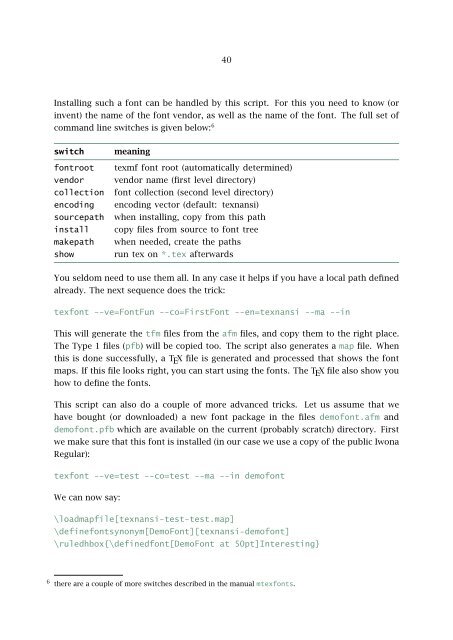font manual - Pragma ADE
font manual - Pragma ADE
font manual - Pragma ADE
You also want an ePaper? Increase the reach of your titles
YUMPU automatically turns print PDFs into web optimized ePapers that Google loves.
40<br />
Installing such a <strong>font</strong> can be handled by this script. For this you need to know (or<br />
invent) the name of the <strong>font</strong> vendor, as well as the name of the <strong>font</strong>. The full set of<br />
command line switches is given below: 6<br />
switch<br />
<strong>font</strong>root<br />
vendor<br />
collection<br />
encoding<br />
sourcepath<br />
install<br />
makepath<br />
show<br />
meaning<br />
texmf <strong>font</strong> root (automatically determined)<br />
vendor name (first level directory)<br />
<strong>font</strong> collection (second level directory)<br />
encoding vector (default: texnansi)<br />
when installing, copy from this path<br />
copy files from source to <strong>font</strong> tree<br />
when needed, create the paths<br />
run tex on *.tex afterwards<br />
You seldom need to use them all. In any case it helps if you have a local path defined<br />
already. The next sequence does the trick:<br />
tex<strong>font</strong> --ve=FontFun --co=FirstFont --en=texnansi --ma --in<br />
This will generate the tfm files from the afm files, and copy them to the right place.<br />
The Type 1 files (pfb) will be copied too. The script also generates a map file. When<br />
this is done successfully, a T E X file is generated and processed that shows the <strong>font</strong><br />
maps. If this file looks right, you can start using the <strong>font</strong>s. The T E X file also show you<br />
how to define the <strong>font</strong>s.<br />
This script can also do a couple of more advanced tricks. Let us assume that we<br />
have bought (or downloaded) a new <strong>font</strong> package in the files demo<strong>font</strong>.afm and<br />
demo<strong>font</strong>.pfb which are available on the current (probably scratch) directory. First<br />
we make sure that this <strong>font</strong> is installed (in our case we use a copy of the public Iwona<br />
Regular):<br />
tex<strong>font</strong> --ve=test --co=test --ma --in demo<strong>font</strong><br />
We can now say:<br />
\loadmapfile[texnansi-test-test.map]<br />
\define<strong>font</strong>synonym[DemoFont][texnansi-demo<strong>font</strong>]<br />
\ruledhbox{\defined<strong>font</strong>[DemoFont at 50pt]Interesting}<br />
6 there are a couple of more switches described in the <strong>manual</strong> mtex<strong>font</strong>s.
















